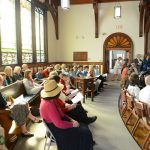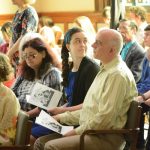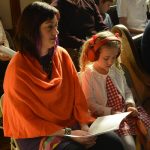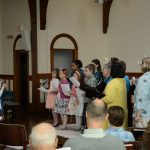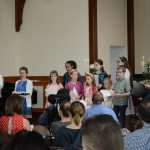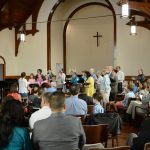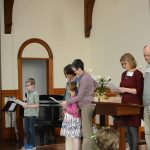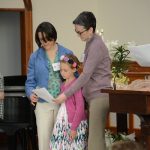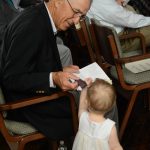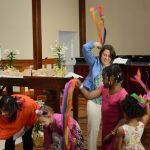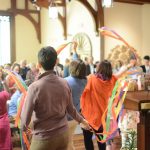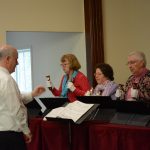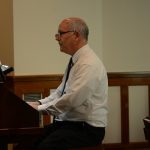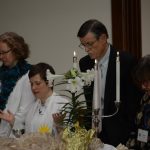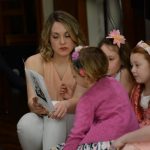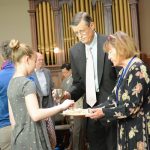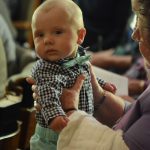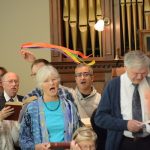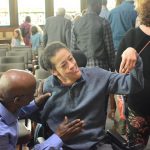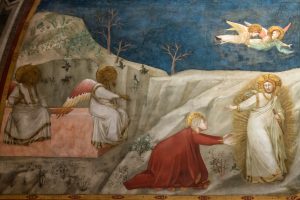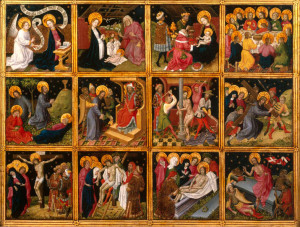Mark 16:1-8
Our Easter story from the Gospel of Mark is a story of surprises. When the Jewish day of Sabbath is over, and the Sunday morning sun is rising, Mary Magdalene, and Mary the mother of James, and Salome bring spices to anoint the body of Jesus. Who knows if they have slept, or if they are thinking clearly. These women are grieving; only two days ago they witnessed Jesus’ death first hand. But, tired, grieving, they still know what needs to be done. So they get up early, and gather what they need, and go to the tomb.
The first surprise is that the stone is already rolled away from the entrance of the tomb. Why would the tomb be open? Then, going into the tomb, the women see – not the body of Jesus, but a very alive young man. The story only gets stranger from here. It seems that this young man is serving as a kind of administrative assistant for Jesus. Apparently Jesus has things to do, people to see, and so this man has taken on the job of delivering Jesus’ away message to whoever shows up at the grave. He says to the women: “Do not be alarmed; you are looking for Jesus of Nazareth, who was crucified. He has been raised; he is not here … But go, tell his disciples and Peter that he is going ahead of you to Galilee; there you will see him, just as he told you.”
This is a story of surprises. And Mary Magdalene, and Mary the mother of James, and Salome do not respond to these surprises calmly. On the contrary, the gospel tells us they are overtaken by alarm and terror; they are startled and awestruck; they tremble with fear and with ecstasy. In fact, they are so overcome that they run away from this man and his news, and say nothing to anyone about what they have seen.
It’s a strange end to the story of Jesus. Later Christians objected to this earliest gospel ending so much that they could not leave it alone. In most bibles, you can read one or two other possible endings for the gospel of Mark. The editors tell us: Don’t worry! This story has a happy ending. This is the kind of story that you can feel good about on Easter, or any other day of the year.
I love the first ending of the gospel of Mark. It feels so honest. Honest, about what hearing this news of resurrection must have been like for those three women. Honest, about what it is like for us, all these years later.
Of course, the news of Jesus’ resurrection is not really a surprise to us. I can’t imagine you’re shocked to hear that Jesus Christ is Risen Today. We all knew there would be flowers, and festive music this morning at church.
But really putting our trust in the news of the resurrection is another thing entirely. I don’t mean the science of it, the logistics of a broken body rising, that is the least difficult part as far as I am concerned. Trusting that Jesus rose from the dead means trusting that love triumphs over hate; that forgiveness is greater than sin; that the story that we’re living in right now in our world today is a story that ultimately has a joyful ending. Trusting in all of that can be struggle for any of us. In fact, in moments of grief, hearing that we are destined for love, forgiveness, and joy through the perplexing power of God may be enough to make us tremble with fear and run away with our hearts broken open.
Luckily, like the women at the tomb, we have more than one opportunity to decide what to do about this resurrection news. More than one chance.
The women, of course, eventually told someone. We know because we have heard the news about Jesus, more than two thousand years later. At some point, Mary Magdalene, and Mary the mother of James, and Salome trusted enough in the news that Jesus is risen to share it with others. We, too, have a new opportunity each day to consider whether we can put our trust in this story, and whether we are brave enough to share it with others.
Today, as you know, is April Fool’s Day. There are creative pastors out there today telling fantastic jokes, and pulling amazing pranks. Bless them. I couldn’t bring myself to do it. I’m sorry, and you’re welcome, depending on how you would have felt about that.
The closest I am getting to April Fool’s Day today is to be foolish enough to invite a room mostly composed of white New Englanders to dance. Some of you may know the hymn Lord of the Dance. I grew up singing it, in the Episcopal church. This hymn is based on a much older hymn, perhaps medieval, which our choir sang recently: Tomorrow shall be my dancing day. Both songs propose that Jesus is a dancer; that he defies every power that tries to keep him down; that he invites us into the dance as well.
Perhaps it is best not to worry too much about whether we are prepared to believe in the surprising news of the resurrection today. How ready we are to trust in the ultimate power of love, forgiveness, and joy. Instead, we could simply consider whether we want to join in the dance; whether we want to allow ourselves to be swayed by God’s irrepressible Spirit. Who knows what could happen, after that.
So in a moment we’re going to sing together. Any children and anyone else who is particularly inspired is invited to come up and dance with Melissa. As for the rest of us, I invite you to move where you are, as the Spirit guides you. Whether you are really ready to let loose or a whether a gentle sway is going too far for you in church, everyone is welcome, just as we are. Let us welcome the eternally surprising news of the resurrection, and join in the dance with Jesus.




